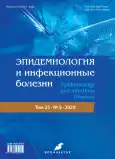Intestinal helminths of dogs in Samarkand and the Samarkand region and their epidemiological significance
- Authors: Turitsin V.S.1,2, Kozlov S.S.2,3, Achilova O.D.4
-
Affiliations:
- Saint-Petersburg State Agrarian University
- Military medical academy of S.M. Kirov
- Saint-Petersburg State Pediatric Medical University
- L.M. Isaev Research Institute of Medical Parasitology
- Issue: Vol 25, No 5 (2020)
- Pages: 210-214
- Section: Original study articles
- URL: https://journals.rcsi.science/1560-9529/article/view/60025
- DOI: https://doi.org/10.17816/EID60025
- ID: 60025
Cite item
Full Text
Abstract
BACKGROUND: Dogs can be a source of various diseases for humans. The study of the helminth fauna of domestic and neglected dogs allows us to assess their danger to humans as a source of infection.
AIMS: To study the intestinal helminth fauna of domestic and neglected dogs living in the city of Samarkand and adjacent areas of the Samarkand region and to assess their epidemiological significance.
MATERIALS AND METHODS: 112 dogs of different ages from Samarkand and the surrounding area were examined. 45 animals were examined by the method of incomplete helminthological autopsy; diagnostic deworming was performed in 12 priotarny dogs; in 55 dogs, feces were examined once by the Fulleborn method.
RESULTS: In the examined dogs, 4 types of cestodes and 4 types of nematodes were found in the intestines. The most common type was dog tapeworm (Dipylidium caninum). The extent of invasion (EI) is 73.7%, the intensity of invasion (AI) is 5–56 copies. Taenia hydatigena tapeworm was detected during preventive deworming in 5 animals out of 12 (41.7%), and at autopsy in 18 dogs out of 45 (40%), AI 1–4 copies. The tapeworm of Echinicoccus granulosus was found in the autopsy of one dog out of 45 (EI 4.4%, AI-more than 350 copies). Mesocestoides lineatus cestodes were observed in the autopsy of 3 dogs (EI 6.7%, AI 1–2 copies). Trichuris (Trichocephalus) vulpis lived in the caecum of 20 dissected animals (EI 88%, AI 5–23 copies). During coproscopy of feces of 55 dogs, whipworm eggs were found in 25 animals (45.5%). Males and females of Toxocara canis were found in the intestines during autopsy of 5 animals (EI 22%, AI 2–4 copies). Eggs Toxocara coproscopy found in the feces of dogs 9 out of 55 (16.4 percent). The EI of the nematode Toxascaris leonina averaged 14.0%. AI 1–3 copies. The nematode Pterygodermatites (Rictularia) affinis was found in the singular (male) in the duodenum of one dissected dog.
CONCLUSIONS: In domestic and neglected dogs living in the territory of Samarkand and the Samarkand region, it was possible to establish the presence of 8 species of intestinal helminths, of which three species are dangerous to humans and have important epidemiological significance: E. granulosus, D. caninum and T. canis.
Keywords
Full Text
##article.viewOnOriginalSite##About the authors
Vladimir S. Turitsin
Saint-Petersburg State Agrarian University; Military medical academy of S.M. Kirov
Email: turicin_spb@mail.ru
ORCID iD: 0000-0001-9066-0026
SPIN-code: 2022-1869
Cand. Sci. (Biol.), Assistant Professor, Department of infectious diseases, with a course in medical Parasitology and tropical diseases
Russian Federation, 2 Peterburgskoe shosse, Pushkin, St. Petersburg, 196601; Saint PetersburgSergei S. Kozlov
Military medical academy of S.M. Kirov; Saint-Petersburg State Pediatric Medical University
Email: infectology@mail.ru
ORCID iD: 0000-0003-0632-7306
SPIN-code: 5519-6057
MD, Dr. Sci. (Med.), Professor
Russian Federation, 6, Acad. Lebedeva street, 194044 Saint Petersburg; Saint PetersburgOlesya D. Achilova
L.M. Isaev Research Institute of Medical Parasitology
Author for correspondence.
Email: aleska-9090@inbox.ru
ORCID iD: 0000-0001-6045-2445
SPIN-code: 9664-0413
Junior research fellow
Uzbekistan, 38 Isayev str., Samarkand, 140105References
- Kozlov DP. Determinant of helminths of predatory mammals of the USSR. Moscow : Nauka; 1977. 257 p. (In Russ).
- Parasitic diseases of humans (protozoans and helminthiasis): Handbook for doctors. Ed. by V.P. Sergiev, Yu.V. Lobzin, S.S. Kozlov. Saint-Petersburg : Folio; 2016. 640 p. (In Russ).
- Podyapolskaya VP, Kapustin VF. Helminthic diseases of man. Moscow : Medgiz; 1958. 663 p. (In Russ).
- Kufs H. Cysticercus tenuicollis and surgical therapy of cysticercosis cerbri [In Undetermined language]. Psychiatr Neurol Med Psychol (Leipz). 1953;5(1-2):13–15.
- Ilkhamov FA. Improvement of traditional and development of new methods of surgical treatment of echinococcosis of the liver [Sovershenstvovanie traditsionnykh i razrabotka novykh metodov khirurgicheskogo lecheniya ehkhinokokkoza pecheni] [dissertation abstract]. Tashkent; 2005. 32 p. (In Russ).
- DPDx ― Laboratory Identification of Parasites of Public Health Concern. Mesocestoidiasis. [Internet]. Available from: https://www.cdc.gov/dpdx/mesocestoidiasis/index.html
- Shulyak BF, Arkhipov IA. Nematodoses of dogs (zoonoses and zooanthroponoses). Moscow : ConsoMed; 2010. 495 p. (In Russ).
- Leikina ES. Main achievements in the study of helminthiasis immunology. Parasitology. 1976;10(2):115–124. (In Russ).
- Erofeeva VV. Ecological and epidemiological problems of toxocarosis in Russia. International Research Journal. 2017;(6):15–19. (In Russ). doi: 10.23670/IRJ.2017.60.005
Supplementary files






